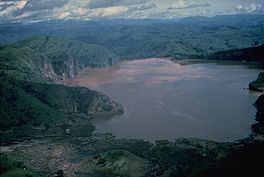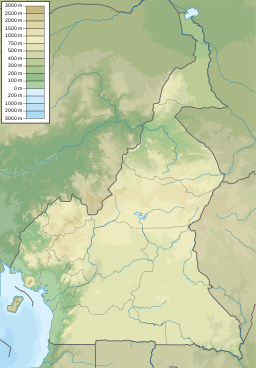
Back Nyosmeer Afrikaans بحيرة نيوس Arabic بحيره نيوس ARZ Ниос Bulgarian Lenn Nyos Breton Llac Nyos Catalan Lake Nyos CEB Nyos Czech Ньос CV Nyossøen Danish
| Lake Nyos | |
|---|---|
 | |
| Location | Northwest Region, Cameroon |
| Coordinates | 06°26′17″N 010°17′56″E / 6.43806°N 10.29889°E |
| Type | Meromictic, limnically active lake, volcanic crater lake |
| Primary inflows | subaquatic source |
| Basin countries | Cameroon |
| Max. length | 2.0 km (1.2 mi) |
| Max. width | 1.2 km (0.75 mi) |
| Surface area | 1.58 km2 (390 acres) |
| Average depth | 94.9 m (311 ft) |
| Max. depth | 208 m (682 ft) |
| Water volume | 0.15 km3 (120,000 acre⋅ft) |
| Surface elevation | 1,091 m (3,579 ft) |
Lake Nyos (/ˈniːoʊs/ NEE-ohs)[1] is a crater lake in the Northwest Region of Cameroon, located about 315 km (196 mi) northwest of Yaoundé, the capital.[2] Nyos is a deep lake high on the flank of an inactive volcano in the Oku volcanic plain along the Cameroon line of volcanic activity. A volcanic dam impounds the lake waters.
A pocket of magma lies beneath the lake and leaks carbon dioxide (CO2) into the water, changing it into carbonic acid. Nyos is one of only three lakes known to be saturated with carbon dioxide in this way, and therefore prone to limnic eruptions (the others being Lake Monoun, also in Cameroon, and Lake Kivu in the Democratic Republic of Congo and Rwanda).
In 1986, possibly as the result of a landslide, Lake Nyos suddenly emitted a large cloud of CO2, which suffocated 1,746 people[3] and 3,500 livestock in nearby towns and villages, the most notable one being Chah, which was abandoned after the incident.[4][5] The limnic eruption not only devastated human and livestock populations but also had a profound impact on the diverse aquatic life, including tilapia, crabs, snails, and frogs, leading to a significant loss of biodiversity in and around the lake.
Though not completely unprecedented, it was the first known large-scale asphyxiation caused by a natural event. To prevent a recurrence, a degassing tube that siphons water from the bottom layers to the top, allowing the carbon dioxide to leak in safe quantities, was installed in 2001. Two additional tubes were installed in 2011.
Today, the lake also poses a threat because its natural wall is weakening. A geological tremor could cause this natural levee to give way, allowing water to rush into downstream villages all the way into Nigeria and allowing large amounts of carbon dioxide to escape.
- ^ "Nyos". Dictionary.com Unabridged (Online). n.d. Retrieved December 15, 2019.
- ^ "21 August: 1986: Hundreds gassed in Cameroon lake disaster". BBC. August 21, 1986. Retrieved December 19, 2008.
- ^ Rouwet, D., Tanyileke, G. and Costa, A. (July 12, 2016). "Cameroon's Lake Nyos Gas Burst: 30 Years Later". Eos. American Geophysical Union. Retrieved December 1, 2016.
{{cite web}}: CS1 maint: multiple names: authors list (link) - ^ New York Times, "Trying to Tame the Roar of Deadly Lakes", February 27, 2001. [1].
- ^ Krajick, Kevin (September 2003). "Defusing Africa's killer lakes" (PDF). Smithsonian. 34 (6): 46–50. Archived from the original (PDF) on April 14, 2005. Retrieved December 9, 2013.

